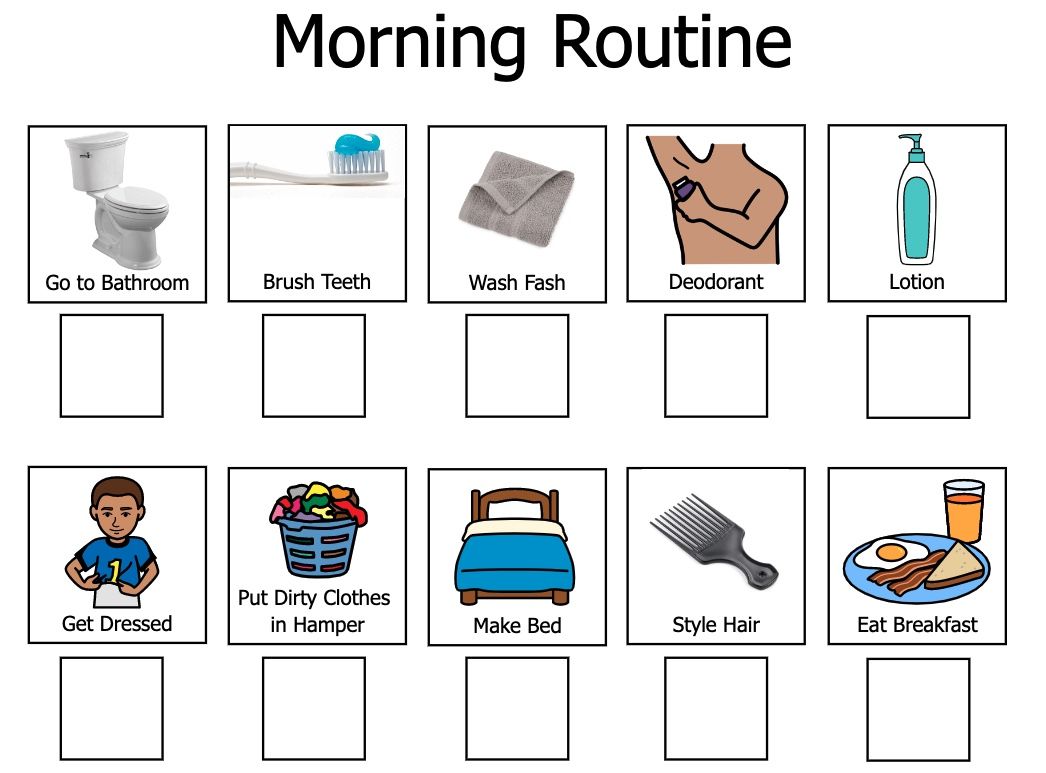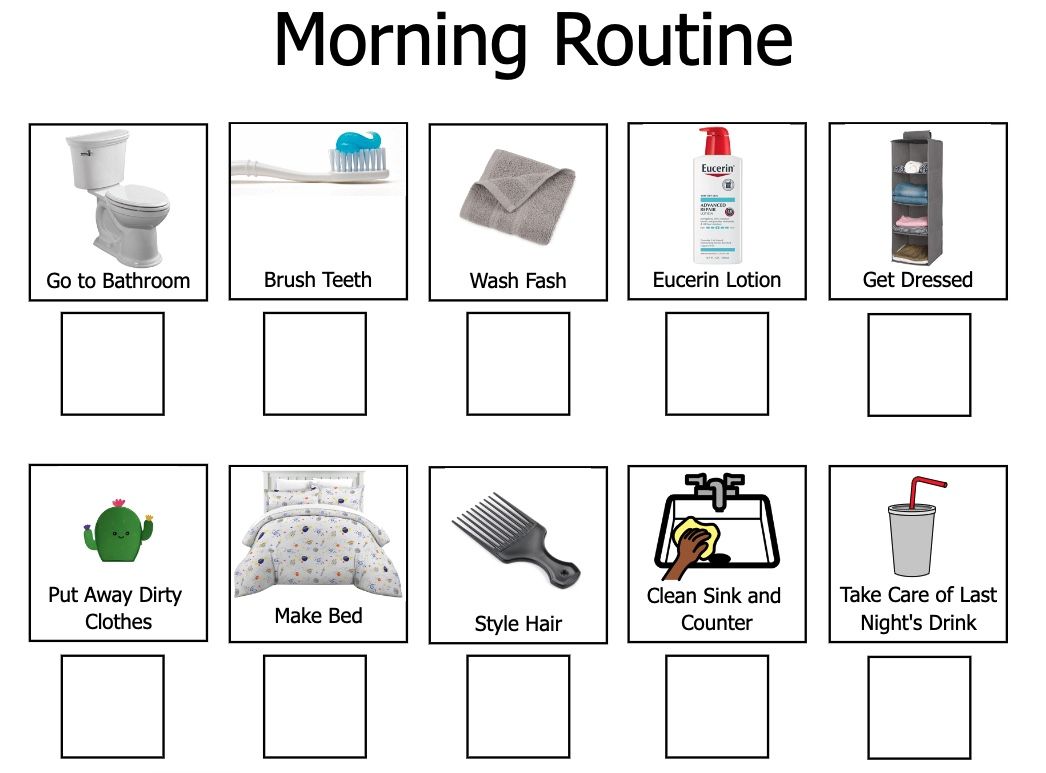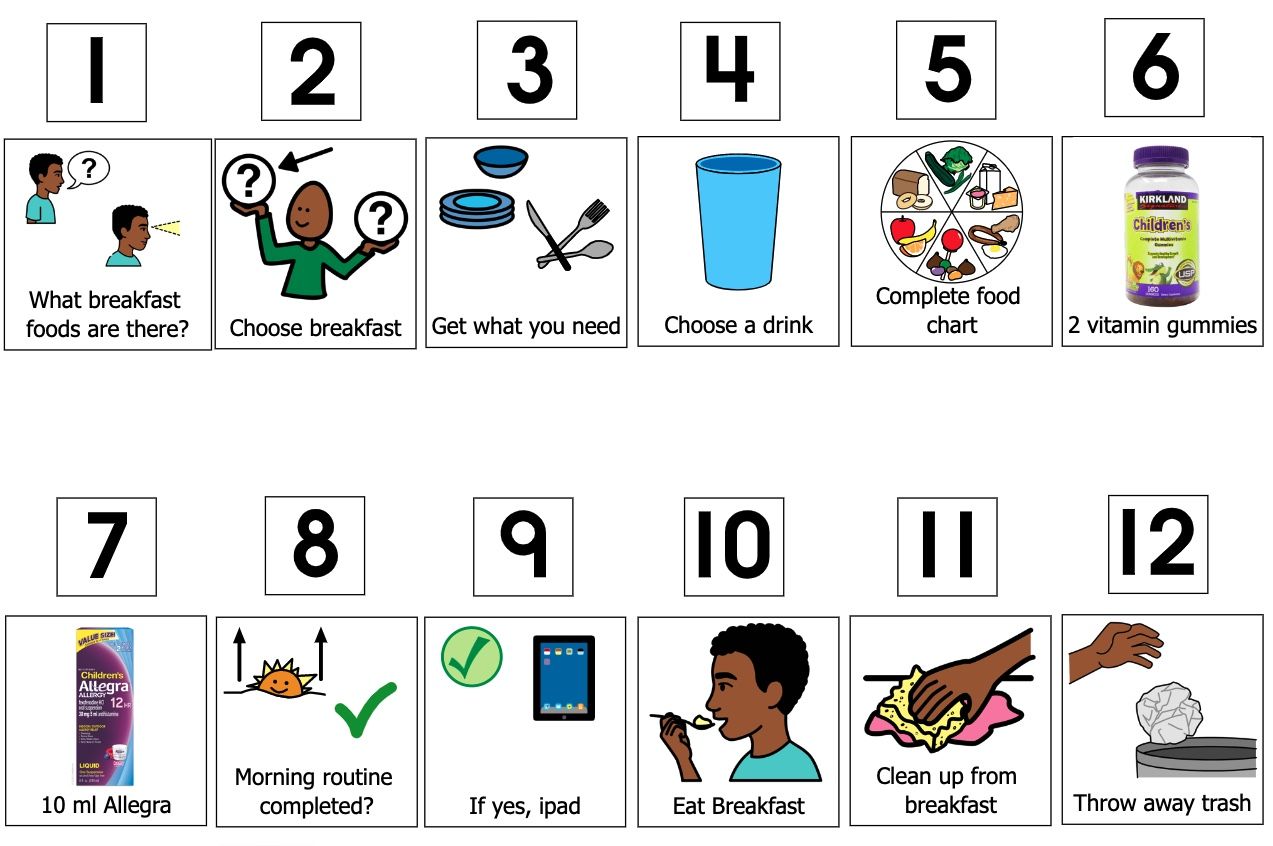Routine Boards
Routines are habits. They are the things we do the same way and in the same order every day. We do them without having to really think about it. They have become muscle memory.
Every morning, I wake up, go into my bathroom, and perform the same daily grooming tasks, in the same way and in the same order. I bet you do too. I know how much time I need to complete all the tasks. If I’m rushed, I know what things I can skip. When I am packing for a vacation, I mentally go through my morning routine to make sure that I have packed everything that I need. And as much as I hate to admit it, if my routine gets interrupted, I may forget a very important step.
There are many routines. We may have a morning, breakfast, after school, dinner, or bedtime routine. Teachers often have routines established for when students enter the classroom or prepare for lunch.
Routine boards use pictures, images and simple words to show the sequence of tasks that need to be completed in the routine. They often include a way to “mark” the tasks as they are completed. I use velcro checkmarks.
Who are routine boards for?
Does your child struggle to remember to pack their lunch in their backpack, remember their homework or house key?
Does your child need prompting to remember tasks they need to do in the morning, afternoon or at bedtime?
Are there tasks that they struggle with or resist to do?
Do you find yourself in a power struggle with your child or dread certain times of the day?
If you answered yes to any of those questions, using a routine board could help.

benefits of using routine boards
Creates Habits
Using the same sequence boards for repetitive tasks can create a routine, helping individuals build habits over time. It is not necessary for the individual to be able to complete the routine independently before using a routine board. The child can follow along on the board and place velcro checkmarks after each task is completed. Placing a velcro checkmark adds a physical component to the board, making it a more powerful tool. They can, first, learn the order of the tasks in a routine. Later, they can learn to complete each task independently.
Reduces anxiety and overwhelm
Each step of the routine is represented by a visual cue. This makes the sequence easy to follow, especially for individuals who may struggle with verbal or written instructions. As each step is completed, it can be “marked off”, giving a clear sense of progress and accomplishment.
Seeing the routine as a sequence of smaller tasks can make it less daunting, helping to reduce anxiety and resistance. If a child has anxiety with a task in the routine, they may try to avoid the whole routine. Having the routine broken down into the separate tasks, help the child focus on the task at hand and not the upcoming on task that they want to avoid.
Using language like “right now, you just need to get dressed. It’s not time to brush your teeth. Let’s focus on getting dressed”, can help them focus on the task they are on and not on the upcoming task that causes anxiety. Often when the time comes to complete the task that they have difficulty with, they have had success with other steps and feel more confident in completing the one that provides some anxiety.
It’s a good opportunity for us to build their confidence with language like “look how well you’ve done! You’ve done __ by yourself!” or “look how well you’ve done! You’ve completed __number of tasks already! You’re almost done!” and then add “I know you can do this step too!”
provides extra support with difficult tasks
Some tasks may present challenges due to sensory issues. Morning routines involving grooming task can be especially challenging. When creating a routine, it is important to consider all the challenges and create a routine in an order that will offer the best chance of success.
For example, when creating a morning routine for my son, I had to place “breakfast” at the very end. Once he was in the kitchen, it was very difficult to get him to return to the bathroom to complete his routine. So, all his dressing and grooming tasks had to be completed first. His first task was going to the restroom and then we brushed his teeth. He had a difficult time with brushing his teeth, so I placed it when we were already in the bathroom. That eliminated the difficulty of having him return to the bathroom to brush his teeth.
Below is my son’s current morning routine. I use pictures of his lotion, laundry basket (cactus), bedding and the shelves that are in his closet. (I put complete outfits for the week, on the shelves, and he get to pick which one to wear that day).

prevents power struggles
My son was making progress, but still struggled with completing all the tasks in his morning routine. I found myself trying to convince, persuade or negotiate with him to complete his routine, which often resulted in a power struggle. I can confirm that parents indeed do not win power struggles. At least I didn’t and it was just an unpleasant experience for both of us. So, I created a second routine board, a breakfast routine. The one pictured below is his current breakfast board. His first one was simplified, but it was the same principle. Notice steps 8 and 9:

Step 8: “Morning routine completed” accompanied by an image of a rising sun and a checkmark.
Step 9: “If yes, iPad” accompanied by an image of a circled checkmark and an iPad.
If my son had completed all his grooming tasks as part of his morning routine, he could have his iPad during breakfast. I didn’t need to convince, persuade, or negotiate with him. All I had to do was ask, “What does your board say?” If he hadn’t completed his morning routine, he couldn’t have it. It was just that simple. In fact, he couldn’t have his iPad at any time, until he had completed his morning routine board.
promotes independence
Let’s looks at the first four steps in my son’s current breakfast routine and how they help promote independence. Every morning, my son would come into the kitchen and ask me what was available for breakfast. We’d go through the same list, which hardly changed throughout the week. This habitual process started to drive me a little crazy because I knew he was capable of being more independent. So, I created a new breakfast routine board. Let’s look at the first four tasks:
“What breakfast foods are available” accompanied with a symbol of someone looking and someone asking. I am okay with him asking me, but only after he has looked in the pantry and fridge.
“Choose breakfast” accompanied with a symbol of someone making a choice between two options.
“Get what you need” accompanied with a symbol of plates, bowls, and utensils.
“Choose a drink” accompanied with a symbol of a cup. Some drinks he can get independently, and others he needs help with. This step prompts him to either get his own drink or ask for help.
I leave the breakfast routine board on the kitchen island where he eats breakfast every morning. It is a visual tool to help guide him through his breakfast routine. If he asks me what breakfast foods are available, I can simply refer to his board and ask, “Did you look first?” It is amazing! I don’t have to go through a whole list of foods, and he is becoming more independent. As his independence has grown, so has his confidence, which in turn has prompted internal motivation for him to become more independent in other areas.
Routine boards are like a gentle guide, helping kids with autism become more independent, confident and comfortable in their daily lives.
Learn more
You can learn how to purchase, print, create and implement a routine board for your child in LEARN.
You can shop for routine boards in the SHOP.
If you need more assistance, you can contact me through my email.
You can find information about customized boards in LEARN and can complete the request form in CONTACT.
.